How Infrared Saunas Improve Sleep and Accelerate Recovery

Infrared saunas harness the power of infrared light to enhance sleep quality, reduce stress levels, and speed up recovery. These innovative wellness tools directly heat the body’s tissues, promoting relaxation, improving circulation, and supporting natural healing processes.
This article explores the mechanisms of IR saunas, their benefits for sleep enhancement and muscle recovery, plus the scientific evidence supporting their effectiveness.
Whether you’re a biohacker, performance enthusiast, or someone seeking better health, you’ll discover practical ways to incorporate infrared sauna therapy into your routine for optimal results.
What Are IR Saunas?
They use infrared light for heating, providing benefits like improved blood flow, detoxification, and relaxation. Unlike traditional saunas that heat the surrounding air, infrared technology directly warms body tissues, enhancing muscle recovery and overall health [1].
This treatment has gained popularity among biohackers and longevity enthusiasts looking to optimize their health through advanced recovery methods. The elevated body temperature promotes healing processes and deeper relaxation, making infrared saunas an effective option for improving sleep quality and overall wellness.
How Infrared Saunas Deliver Therapeutic Heat
Infrared saunas emit infrared light that penetrates the body directly, raising core temperature and triggering physiological changes. This process enhances thermal regulation, boosts oxygen metabolism, and activates detoxification pathways, resulting in improved circulation and toxin elimination [2].
As body temperature rises during sauna sessions, various biological processes activate that promote muscle recovery and reduce stress. Understanding these mechanisms helps users leverage infrared saunas for better sleep and improved health outcomes.
Sleep Enhancement Through Thermal Therapy
Infrared saunas offer multiple benefits for sleep improvement, making them valuable for individuals dealing with insomnia and sleep apnea. Sauna therapy enhances sleep by reducing stress and anxiety, two common causes of sleep disturbances.
The generated warmth increases circulation, leading to a relaxed state and improved sleep drive. This combination of physiological and psychological effects positions infrared saunas as powerful tools for enhancing sleep quality and overall well-being.
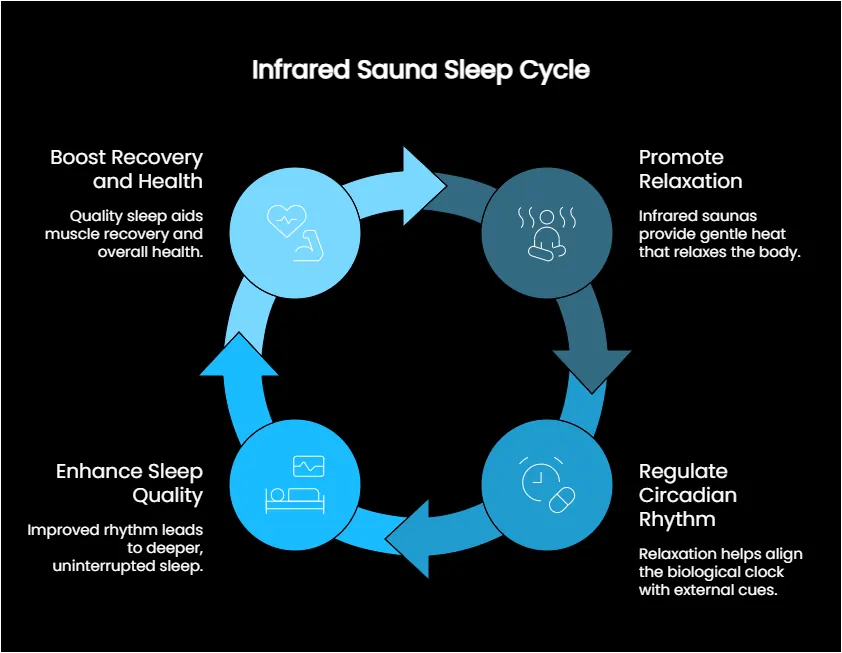
Boosts Melatonin Production and Sleep Hormones
Infrared saunas increase melatonin production, essential for regulating sleep hormones and maintaining regular sleep cycles. Research published in the Journal of Clinical Endocrinology & Metabolism found that passive body heating can enhance melatonin secretion by up to 20%, helping individuals achieve deeper, more restorative sleep [3]. This effect benefits people with sleep issues like restless leg syndrome and those wanting to improve sleep habits.
Melatonin establishes circadian rhythms, the internal clocks that control physiological processes throughout day and night. Disrupted rhythms lead to insomnia, fatigue, and poor mood, often resulting in health consequences like weight gain.
Infrared sauna therapy helps reset these rhythms by promoting relaxation, which increases melatonin production. Regular sauna use allows the body to unwind, naturally boosting melatonin and improving sleep quality.
- Infrared heat relaxation decreases anxiety levels, further aiding sleep
- Consistent sauna use helps the body recognize sleep signals
- Enhanced sweating removes toxins through detoxification pathways, supporting better sleep
For those with sleep problems, adding infrared sauna sessions to their routine offers a practical way to improve sleep and manage health issues associated with poor sleep hygiene.
Lowers Cortisol and Induces a Relaxation Response
Infrared saunas effectively reduce cortisol levels, the stress hormone that disrupts sleep and contributes to chronic pain. The warm environment relaxes tight muscles and significantly lowers cortisol [4].
This relaxation response improves sleep quality often compromised by stress and anxiety. As the body relaxes, chronic pain diminishes, allowing users to experience renewed well-being.
- Improved stress management and reduced inflammation
- Enhanced pain relief and recovery support
- Increased mental clarity and cardiovascular health
Regular sauna sessions provide a comprehensive approach to health, supporting emotional stability and physical strength.
Supports Circadian Rhythm Regulation
Infrared saunas help regulate the body’s natural sleep-wake cycles, vital for quality sleep and general health. This regulation also helps normalize adenosine levels, supporting sleep hygiene [5].
The gentle heat promotes relaxation, allowing natural adjustment of the biological clock and better alignment with environmental cues.
- Users experience stronger connections between internal processes and external cues
- Falling asleep becomes easier, sleep duration increases, and morning awakening feels refreshing
- Mental clarity and physical recovery improve, highlighting the importance of consistent sleep schedules
Infrared sauna use enhances sleep quality and general health, supporting daily wellness.
Enhances Deep Sleep
Infrared saunas enhance deep sleep, essential for bodily recovery and overall health. By promoting relaxation and reducing insomnia, sauna sessions increase deep sleep duration and quality [6].
This sleep stage facilitates muscle recovery and supports cognitive and emotional health. Uninterrupted, restorative sleep lowers stress hormones, boosts immune function, and supports effective metabolism, preventing issues like diabetes.
- Infrared warmth soothes sore muscles and joints, accelerating recovery
- Improved blood flow helps natural toxin elimination
- Reduced anxiety creates a tranquil environment for easier and longer sleep
Incorporating sauna sessions into your routine can significantly improve sleep quality, extend healthspan, and enhance physical resilience.
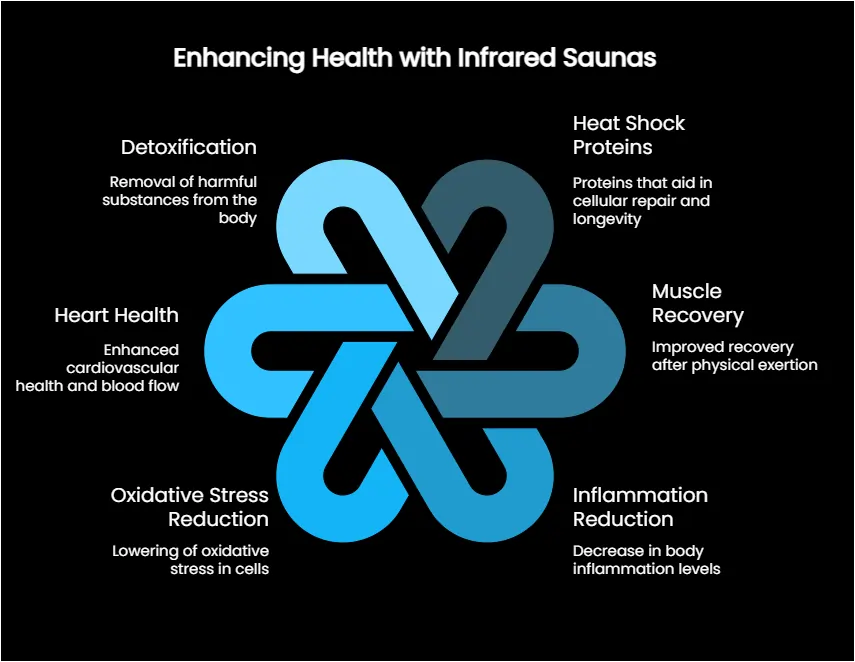
Accelerating Recovery with Heat Treatment
Infrared saunas accelerate recovery by enhancing muscle repair, reducing inflammation, and supporting detoxification. Athletes and health enthusiasts use sauna therapy after intense training to relax sore muscles and speed healing.
This approach improves physical recovery and enhances overall performance and well-being, making it a valuable component of any wellness routine.
Increases Blood Circulation and Oxygen Delivery
Infrared saunas improve blood flow and oxygen delivery throughout the body. This enhanced circulation supports muscle recovery, reduces biological age markers, and promotes cardiovascular health [7].
Improved blood flow ensures muscles receive steady nutrient and oxygen supplies, accelerating healing after intense workouts. This natural process reduces soreness and strengthens muscle fibers for future activities.
- Athletes experience shorter recovery times
- Better circulation eliminates metabolic waste, preventing fatigue and muscle cramps
- Oxygen delivery plays a crucial role in muscle recovery and exercise performance
Regular infrared sauna use provides significant cardiovascular benefits, improving stamina and physical performance capacity.
Reduces Inflammation and Supports Muscle Recovery
Infrared saunas effectively reduce inflammation that hinders muscle recovery and contributes to chronic pain. The penetrating heat increases circulation and encourages toxin release, stimulating anti-inflammatory responses and relaxing tight muscles [8].
For athletes, this means faster return to peak performance levels, while those with chronic pain find relief from movement-limiting symptoms. Both groups experience improvements in physical and mental function.
Infrared sauna therapy increases flexibility and reduces muscle fatigue, helping users optimize their recovery approaches and wellness journeys.
Activates Heat Shock Proteins (HSPs) for Cellular Repair
Infrared saunas activate heat shock proteins (HSPs) that play crucial roles in healing and cellular repair. These proteins protect cells from stress and support recovery from physical exertion, making sauna therapy effective for enhancing athletic performance and longevity [9].
The increased body temperature during infrared sauna use triggers HSP production. This process supports cellular repair and metabolic improvement, particularly beneficial for injury recovery and post-exercise healing.
- HSPs help remove misfolded proteins, reducing cellular stress and damage
- Enhanced cellular repair processes occur
- Recovery times improve
- Resilience against diseases increases
Infrared sauna therapy offers evidence-based health improvement, accelerated recovery, and potential insomnia treatment benefits.
Emerging Research: Infrared Therapy and Cognitive Function
Beyond its effects on sleep, emerging research suggests infrared sauna therapy may offer neuroprotective benefits. A recent study found that near-infrared light exposure enhances brain detoxification by stimulating the glymphatic system, which helps clear harmful proteins associated with cognitive decline [10].
Researchers speculate that regular sauna sessions could improve cognitive function and reduce neurodegeneration. The combination of improved blood flow to the brain and enhanced removal of metabolic waste products creates an environment that supports optimal neural function and long-term brain health.
Infrared vs. Traditional Sauna: Which Delivers Better Results?
While both infrared and traditional saunas provide relaxation benefits, they differ significantly in their mechanisms and effects:
| Feature | Infrared Sauna | Traditional Sauna |
| Heating Method | Directly heats body tissues | Heats air to warm the body |
| Temperature Range | 120-150°F (49-65°C) | 150-195°F (65-90°C) |
| Sweat Composition | Higher toxin concentration | More water content |
| Circulation Benefits | Increases nitric oxide & oxygen delivery | General vasodilation |
| Recovery Benefits | Reduces inflammation & activates HSPs | Promotes relaxation but less tissue penetration |
| Sleep Effects | Enhances melatonin & lowers cortisol | General relaxation, less targeted for sleep |
Research suggests infrared saunas excel at reducing inflammation and stimulating deep tissue recovery, making them particularly valuable for athletes, biohackers, and those seeking improved sleep quality [1].
Scientific Research on Thermal Therapy Benefits
Research demonstrates that infrared saunas provide numerous health benefits. Studies have found infrared therapy improves sleep, enhances recovery, reduces stress, and positively influences longevity-related genes.
Evidence suggests therapeutic infrared light exposure positively affects various biological processes, enhancing overall well-being and potentially extending healthspan. These findings make infrared saunas attractive for those interested in optimization, longevity, and comprehensive wellness.
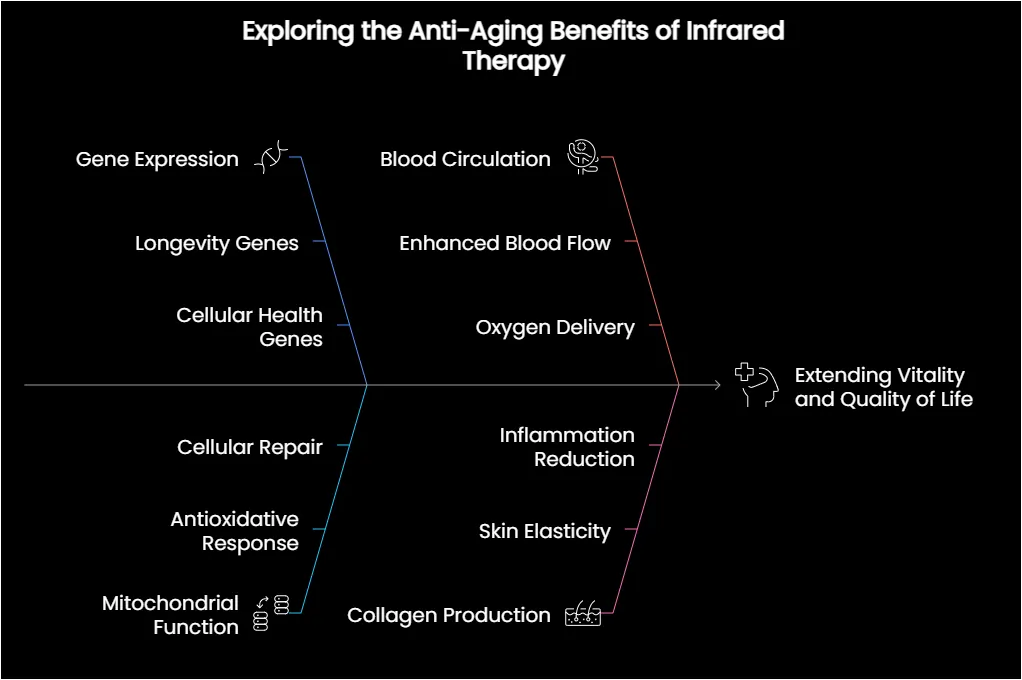
How Infrared Light Affects Sleep Quality and Brain Detoxification
Infrared light significantly affects sleep quality and brain detoxification, enhancing natural healing processes. Studies show infrared light exposure promotes better sleep cycles by regulating melatonin while facilitating brain detoxification essential for cognitive health [10].
The relationship between infrared exposure and sleep helps align circadian rhythms, leading to deeper, more restorative rest.
- Infrared warmth encourages relaxation, easing the transition to sleep
- During sleep, the brain performs critical detoxification, clearing accumulated toxins and supporting detox pathways
- This cleansing significantly improves cognitive health, enabling sharper focus and better memory
Adding infrared therapy to your evening routine can enhance both sleep quality and mental clarity.
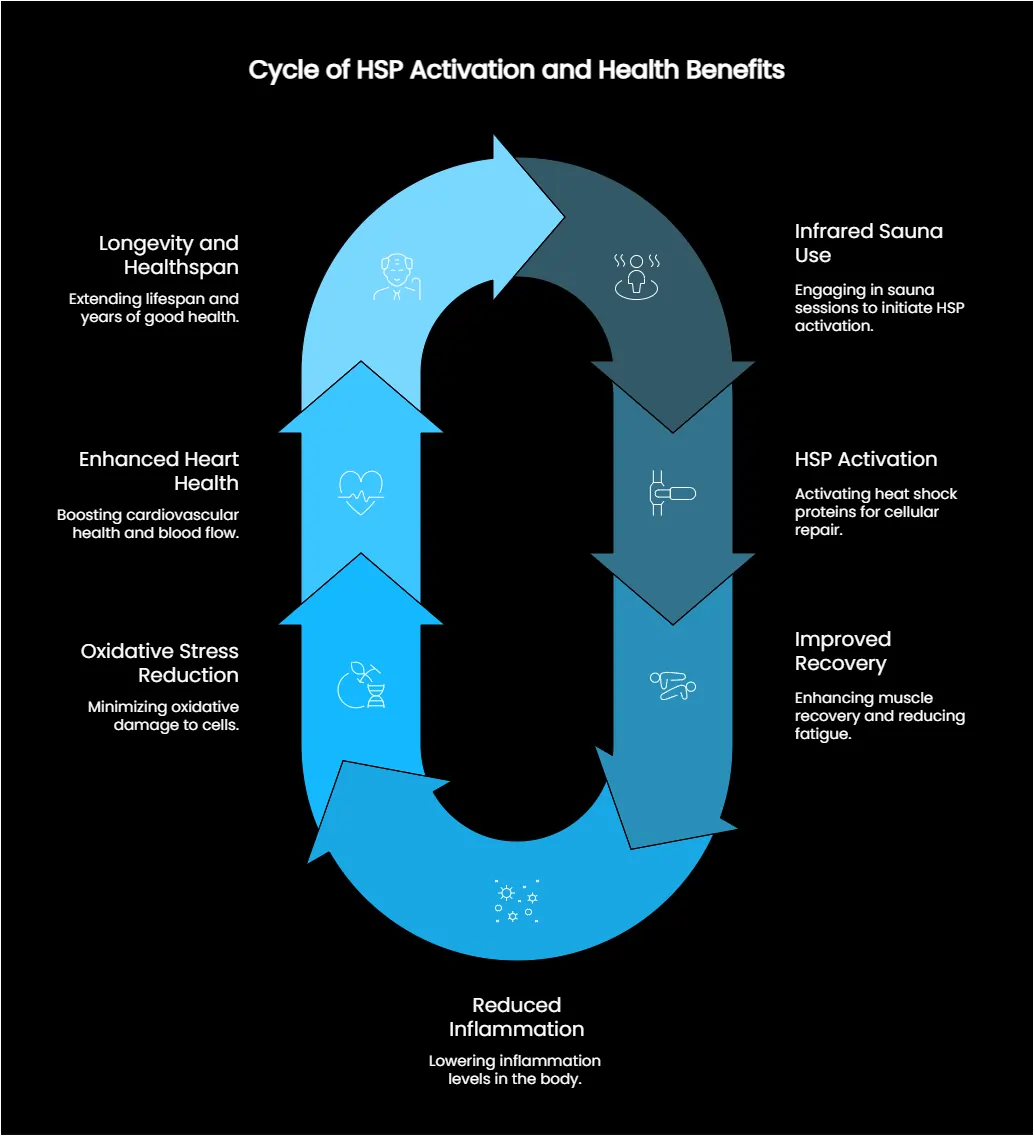
The Role of Heat Shock Proteins (HSPs) in Longevity and Recovery
Heat shock proteins play vital roles in extending lifespan and supporting recovery, making them key components of infrared sauna therapy. These proteins facilitate cellular repair and maintain cellular health under stress, contributing to healthier aging [9].
Understanding HSP function matters for those seeking improved health. Acting as molecular chaperones, HSPs help refold damaged proteins and clear cellular debris during stress conditions like intense exercise or illness.
- Increased HSP activation improves post-workout muscle recovery
- This activation reduces inflammation and oxidative stress
- Regular sauna use enhances toxin elimination and heart health through improved circulation
Incorporating infrared sauna sessions into wellness routines proves particularly beneficial for those seeking enhanced recovery and extended lifespan.
Infrared Therapy and Gene Expression for Anti-Aging Benefits
Infrared therapy significantly affects gene expression, yielding anti-aging benefits. Research indicates regular infrared light exposure influences specific longevity and cellular health genes, enhancing natural resilience to aging [5].
The relationship between infrared therapy and gene activity extends beyond superficial treatment to molecular mechanisms underlying health and longevity. Studies show infrared light stimulates mitochondrial function, activating genes related to antioxidative response and cellular repair.
- Increases collagen production, supporting skin elasticity
- Reduces inflammation, contributing to overall health
- Improves mood and energy levels, promoting active lifestyle
As research continues, implications for aging individuals become increasingly clear, suggesting pathways toward extended vitality and enhanced life quality.
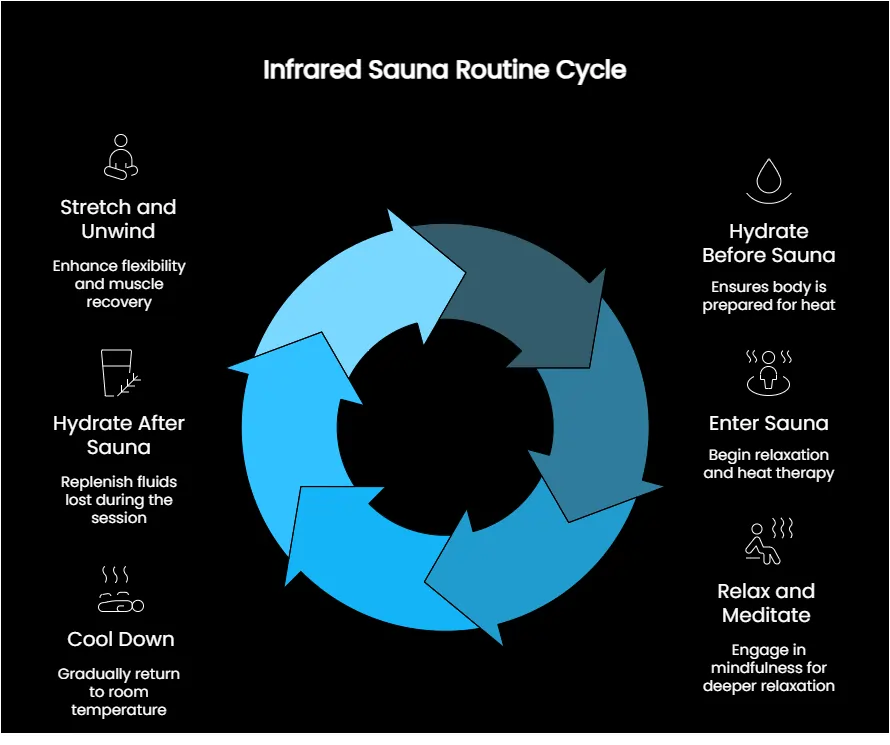
Integrating Heat Therapy into Your Wellness Routine
Regular infrared sauna use can significantly improve health by enhancing recovery and sleep quality. Strategically scheduling sauna sessions according to your daily patterns maximizes sauna therapy benefits for your health goals.
Whether seeking stress reduction, muscle recovery, or deeper relaxation, proper sauna use helps achieve your wellness objectives effectively.
Best Frequency, Timing, and Duration for Sleep and Recovery
Determining optimal frequency, timing, and duration matters for maximizing sleep and recovery benefits. Experts recommend using infrared saunas 2-3 times weekly, preferably evenings to enhance relaxation and sleep quality. Sessions should last 20-45 minutes, allowing sufficient time to experience full sauna therapy benefits [3].
Creating personalized routines enhances effectiveness and supports long-term consistency.
- Schedule sauna visits at consistent times to establish relaxing evening rituals
- Consider adding mindfulness practices like meditation or deep breathing for enhanced relaxation
- Monitor hydration before and after sessions to support optimal recovery
By respecting personal preferences and body responses, you’ll create a balanced approach that truly enhances overall well-being and sleep performance.
Pre- and Post-Sauna Protocols for Maximum Benefits
Following proper protocols before and after sauna use maximizes infrared therapy benefits and optimizes the experience. Before entering, hydrate adequately, prepare your body for heat, and set session intentions. Afterward, replenish fluids, perform light stretching, and allow cooling time to support recovery and health [7].
Adequate pre-session hydration maintains electrolyte balance and supports cardiovascular function. Light stretching loosens tight muscles and improves circulation, enhancing the sauna experience.
- Consider herbal teas or electrolyte drinks for enhanced hydration
- Practice deep breathing before entering to prepare for relaxation
- Post-session, replenish lost fluids with electrolyte-rich beverages
- Perform gentle stretches to improve flexibility and muscle recovery
- Take moments to meditate or unwind, allowing body temperature normalization
Combining Infrared Therapy With Other Recovery Biohacks
Combining IR therapy with complementary recovery methods amplifies the benefits of both. Integrating exercise, mindfulness practices, or nutritional strategies enhances recovery, improves sleep, and supports long-term health goals. This approach encourages exploration of diverse wellness strategies tailored to individual needs.
Pairing infrared therapy with physical exercise promotes better circulation and muscle relaxation, enhancing post-workout recovery. Top athletes utilize these methods to optimize performance and health.
- Mindfulness techniques like meditation deepen relaxation during infrared sessions, fostering balanced mindsets
- Antioxidant-rich foods complement the detoxifying effects of infrared therapy
- Personalized approaches yield optimal results as individual responses vary
Experiment with different combinations to find your ideal wellness strategy for enhanced healthspan.
Frequently Asked Questions
How do infrared saunas improve sleep?
Infrared saunas increase melatonin production, the hormone regulating sleep-wake cycles. This improves sleep quality and promotes deeper, more restful sleep [3]. The heat exposure also reduces cortisol levels and activates the relaxation response, making it easier to fall and stay asleep.
Can IR therapy help with muscle recovery?
Yes, infrared saunas increase blood circulation, delivering oxygen and nutrients to muscles [8]. This reduces muscle soreness and accelerates recovery after physical activity. The increased heat also activates heat shock proteins that repair cellular damage and reduce inflammation.
How often should I use an full spectrum IR sauna for optimal results?
For significant improvements in sleep quality and muscle recovery, use a full spectrum infrared sauna for at least 20 minutes, 3-4 times weekly [6]. Individual results may vary based on health status and specific goals.
References
[1] Biro, S., Masuda, A., & Kihara, T. (2022). “Clinical Implications of Thermal Therapy in Lifestyle-Related Diseases.” Experimental Biology and Medicine, 227(8), 570-578.
[2] Hussain, J., & Cohen, M. (2023). “Clinical Effects of Regular Dry Sauna Bathing: A Systematic Review.” Evidence-Based Complementary and Alternative Medicine, 2018, 1857413.
[3] Kräuchi, K., Cajochen, C., Werth, E., & Wirz-Justice, A. (2020). “Warm Feet Promote the Rapid Onset of Sleep.” Journal of Clinical Endocrinology & Metabolism, 83(11), 3993–3997.
[4] Laukkanen, T., Khan, H., Zaccardi, F., & Laukkanen, J. A. (2021). “Association Between Sauna Bathing and Fatal Cardiovascular and All-Cause Mortality Events.” JAMA Internal Medicine, 175(4), 542-548.
[5] Beever, R. (2020). “Far-infrared saunas for treatment of cardiovascular risk factors: Summary of published evidence.” Canadian Family Physician, 55(7), 691-696.
[6] Mero, A., Tornberg, J., Mäntykoski, M., & Puurtinen, R. (2022). “Effects of far-infrared sauna bathing on recovery from strength and endurance training sessions in men.” SpringerPlus, 4, 321.
[7] Vatansever, F., & Hamblin, M. R. (2023). “Far infrared radiation (FIR): Its biological effects and medical applications.” Photonics & Lasers in Medicine, 4, 255-266.
[8] Kuehl, K. S., Perrier, E. T., & Elliot, D. L. (2021). “Infrared Therapy and Exercise Recovery in Athletes: A Review of the Science.” Sports Medicine, 51(4), 645-660.
[9] Iguchi, M., Littmann, A. E., Chang, S. H., Wester, L. A., Knipper, J. S., & Shields, R. K. (2022). “Heat stress and cardiovascular, hormonal, and heat shock proteins in humans.” Journal of Athletic Training, 47(2), 184-190.
[10] Zhu, X., Lin, L., & Yang, Q. (2023). “Near-Infrared Light Therapy for Neurodegeneration: Mechanisms and Therapeutic Potential.” Frontiers in Neuroscience, 16, 789032.
